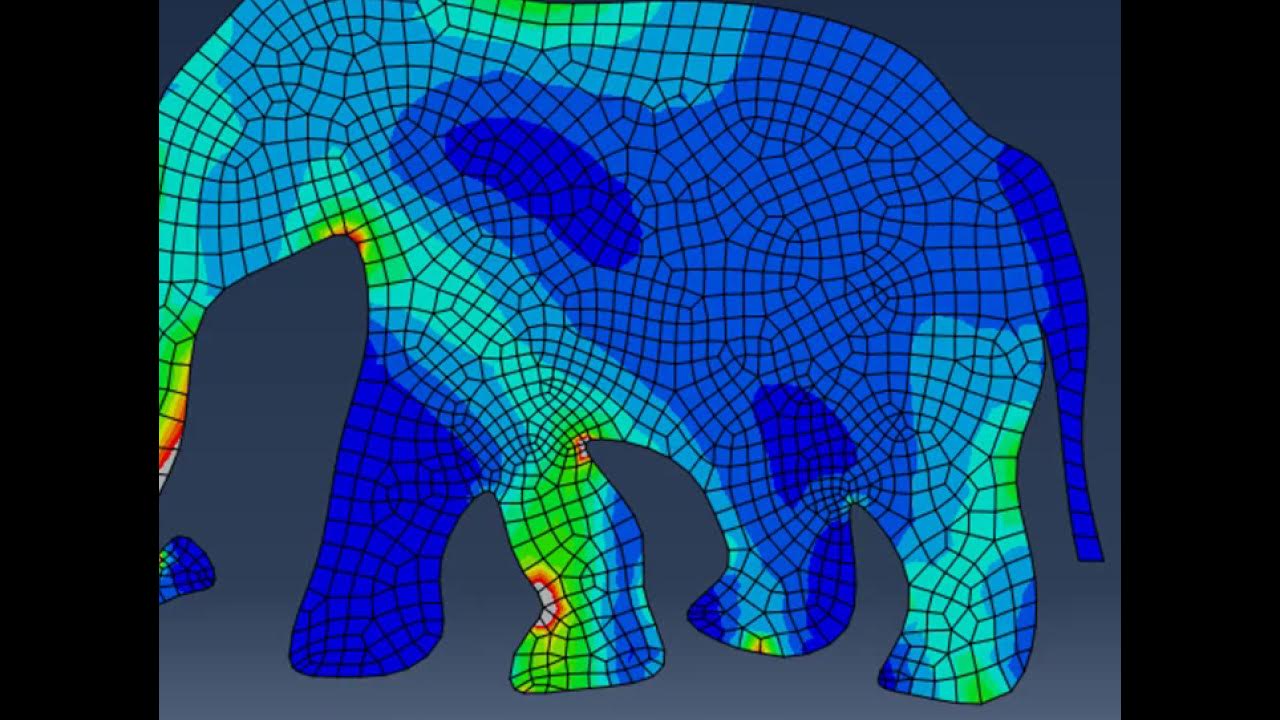FEA 24: 2-D Rectangular Elements
Summary
TLDRThis video explains the development of a 2D rectangular finite element with four nodes, using a bilinear displacement field. It covers defining the element's displacement, stress, and strain fields, and constructing its shape function matrix and stiffness matrix. The video explores how strain and displacement are related, deriving the B matrix, and emphasizes the difference between the rectangular and triangular elements. It concludes by discussing the issue of shear locking in pure bending scenarios and how it affects the accuracy of the model.
Takeaways
- 📐 The video explains the development of a 2D rectangular element with four nodes and a bilinear displacement field.
- 📝 Defining a new element requires specifying the displacement, stress, and strain field vectors, along with element geometry and degrees of freedom.
- 🔢 Shape function matrices help relate strain and displacement, leading to the B matrix and stiffness matrix, but transformations are not covered in this video.
- 🧮 The displacement field is expanded with four coefficients for each polynomial, making it bilinear — linear in both x and y directions.
- ⚙️ The degree of freedom vector has eight terms in total (two per node), representing displacements in both x and y directions for each node.
- 🧩 Matrix manipulations simplify the resolution of unknown coefficients, transforming them into expressions dependent on degrees of freedom.
- 🗺️ Shape functions are derived for each degree of freedom and arranged into a shape function matrix for efficient computation.
- 📊 The B matrix is derived from partial derivatives of the shape function matrix, resulting in a linear variation of strain in the bilinear rectangular element.
- 🔍 The B matrix can be used to calculate the strain at specific points within the element, such as the center and the node locations.
- ❗ The video highlights a phenomenon called 'shear locking,' where unexpected shear strain appears during pure bending, leading to less deflection in finite element analysis compared to reality.
Q & A
What is a 2D rectangular element in the context of this video?
-A 2D rectangular element is a finite element with four nodes, each with two degrees of freedom. It has a bilinear displacement field inside, meaning the displacement is linear in both the x and y directions.
What are the key components needed to define a new element?
-To define a new element, we need to specify the displacement field, the stress and strain field vectors, the element geometry, the degree of freedom vector, and the number of nodes. These help form the shape function matrix and the B matrix, leading to the stiffness matrix and the element force vector.
What is meant by a 'bilinear displacement field'?
-A bilinear displacement field refers to a displacement that is linear in both x and y directions. Even though the displacement may include a quadratic term like XY, it is still linear in terms of each individual direction.
Why is the X'Y' coordinate system used in defining the element geometry?
-The X'Y' coordinate system is chosen for balance, with the origin placed at the center of the element to make it easier to balance displacements and deformations symmetrically from left to right and top to bottom.
How are the shape functions derived for the rectangular element?
-The shape functions are derived by evaluating the displacement field at each node of the element and resolving the unknown coefficients of the polynomial displacement expression in terms of the degrees of freedom. The displacement field is then expressed as a combination of shape functions multiplied by the degrees of freedom.
What is the B matrix, and how is it computed?
-The B matrix, or the strain-displacement matrix, is obtained by multiplying the partial derivative matrix operator by the shape function matrix. It relates the strain to the nodal displacements in the element.
How does the B matrix differ between triangular and rectangular elements?
-For the rectangular element, the B matrix depends on x and y, leading to a linear variation of strain within the element. In contrast, for a triangular element, the B matrix is constant, resulting in constant strain throughout the element.
Why is evaluating the B matrix at different positions within the element important?
-Evaluating the B matrix at different positions, such as the center or the nodes, allows us to calculate the strain at those specific points. Since strain varies within the element, this helps in understanding the strain distribution.
What happens when the rectangular element is subjected to pure bending?
-When the rectangular element undergoes pure bending, one side gets compressed while the other side is stretched, turning the rectangle into a trapezoid. The displacement field corresponds to this bending, and the strain can be calculated using the B matrix.
What is 'shear locking,' and how does it occur in this context?
-Shear locking occurs when unexpected shear strain appears in pure bending scenarios, where no shear forces are applied. This happens because the bilinear element introduces shear strain, which absorbs some bending energy, resulting in less deflection than expected.
Outlines

このセクションは有料ユーザー限定です。 アクセスするには、アップグレードをお願いします。
今すぐアップグレードMindmap

このセクションは有料ユーザー限定です。 アクセスするには、アップグレードをお願いします。
今すぐアップグレードKeywords

このセクションは有料ユーザー限定です。 アクセスするには、アップグレードをお願いします。
今すぐアップグレードHighlights

このセクションは有料ユーザー限定です。 アクセスするには、アップグレードをお願いします。
今すぐアップグレードTranscripts

このセクションは有料ユーザー限定です。 アクセスするには、アップグレードをお願いします。
今すぐアップグレード5.0 / 5 (0 votes)






